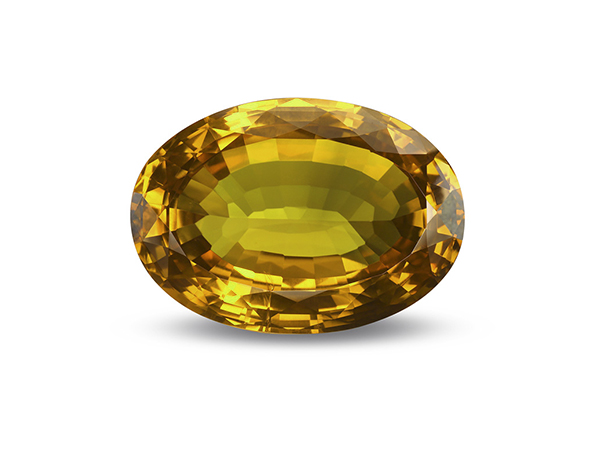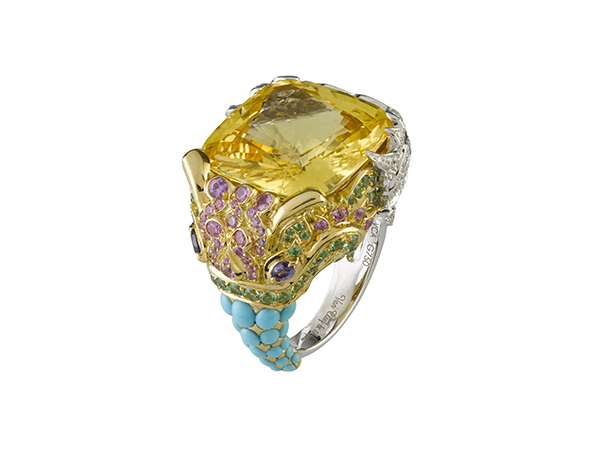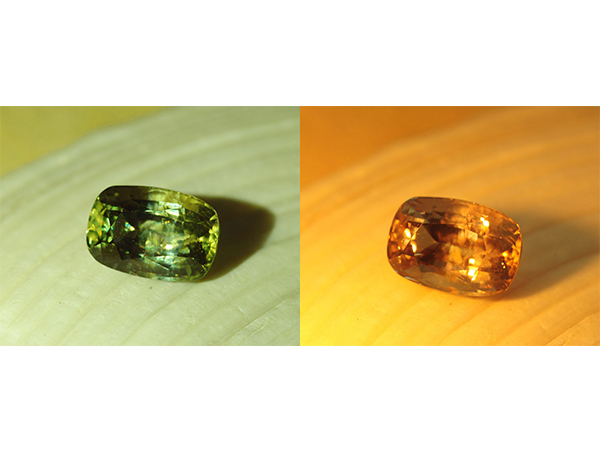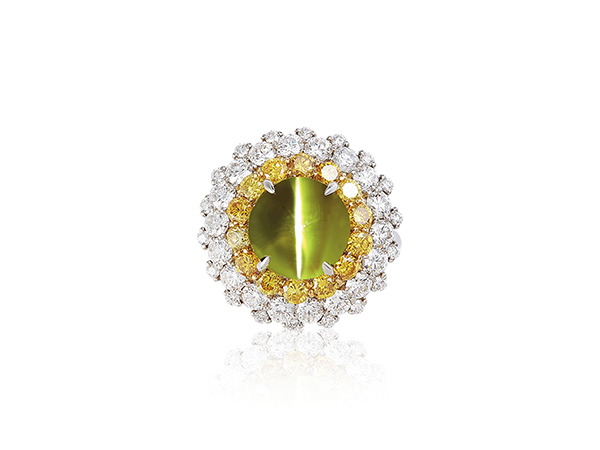CHRYSOBERYL

It is a precious gemstone with four variants: cat's eye, stone, stone cat's eye and gold emerald crystal. It is mainly produced in granite, fine-grained rock and mica rock, and also found as a clastic mineral in the gravel layer.
The name "Golden Emerald" is derived from the Greek word for "golden beryl", but today it is said that the golden beryl refers to the golden beryl.
Gold emeralds generally have a glass luster to a ruthenium gloss, a yellow to green color, and a trichromaticity. The yellow color is derived from iron ions, and the trace elements such as chromium and titanium contained in it cause special optical effects. Among them, the gold emerald with color change effect is called marble; the gold emerald with cat eye effect is called cat eye; If the cat's eye is changed to have a discoloration and cat's eye effect, if neither of them is available, the name of the gold emerald is used directly.
Gold emerald itself is a rare mineral. If it can be cut into large particles and the color purity is better, the precious stone is very precious. Among the gold emeralds, the public is familiar with the cat’s eye, which is one of the most beautiful gemstones in nature with its silky luster and sharp eyeliner. The other three belong to the early stage of cognition and have a relatively large collection prospect.
Introduction
The English name for gold emerald is Chrysoberyl, which is derived from Greek Chrysos (Gold) and Beryuos (Emerald), meaning "Golden Emerald". Also known as "Golden Green Jade" and "Golden Green" in the jewelry industry. Gold emerald itself is a rare mineral, and it is less precious to form cat's eye and discoloration effect, so it is very precious. Among the gold emeralds, the most famous one is the golden green cat's eye.
Gold emeralds usually have a good transparency and are yellow or yellowish green, hence the name. Most are cut into faceted gemstones to express their excellent fire. Produced in Brazil, Sri Lanka and Madagascar.
The market price is still at a low level. Because it has the advantages of all high-grade gemstones and the color is special, it does not rule out the time when the price of the gemstone rises after people understand it.
Gold emeralds are oxides of bismuth and aluminum, which are of high quality and are extremely precious. Gold emeralds are generally thick plate-shaped, transparent with a glass luster, varying in shades of green or yellow to brown, and some emit different colors under different light sources.
Gold emeralds are mainly produced in granitic pegmatites, fine-grained rocks and mica schist, and are also found in the gravel layer as detrital minerals. Because it is very hard and wearable, it also exists in streams and gravels. Artificial methods can produce gold emeralds, but the quality is not as good as natural.

Hardness 8.5, density 3.71-3.75 g / cm3. Shell-shaped fracture. Excellent toughness. The green-yellow gold emerald produces green-yellow fluorescence under short-wave ultraviolet light. Acid is not eroded. There are strange cat eyes or discoloration effects.
The chemical formula is similar to spinel, so it is also called spinel, but its crystal structure and crystal form are similar to olivine (olivine). Crystals are often thick plate-like; often formed into a heart-shaped double crystal or a pseudo-hexagonal through the triple crystal. With good cylindrical cleavage. Moss hardness of 8.5, specific gravity of 3.63 ~ 3.83. Transparent, glassy, dark or light green or yellow to brown.
A variant containing a small amount of Cr3+ which is green in daylight and red in transmitted light and under artificial light such as candlelight. It is called a metamorphic stone and is called alexandrite in the Chinese gem industry.
Another variant, which is light green and has acicular inclusions with many microscopic cavities and parallel distributions, with protein light and live light (see Quartz family minerals), is called gold emerald cat's eye, mainly produced in Sri Lanka. Also known as the Oriental Cat's Eye and Ceylon Cat's Eye. The world's most important gold emerald is produced in Minas Gerais, Brazil, while Russia's Urals and Sri Lanka are famous for producing stone and gold-green opal. Gold emeralds can also be artificially synthesized by flame melting, but as gem materials, their quality is far less than that of natural crystals.
Structure and production
The orthorhombic system of the gold emerald is also called the orthorhombic system. The oxygen ions are densely packed in a hexagonal manner, the strontium ions are located in the tetrahedral coordination center, and the aluminum ions are located in the octahedral coordination center. Among the common natural gemstones, the hardness of gold emeralds ranks third, reaching 8.5, between corundum (9) and topaz (8). One feature of the gold emerald is a ring-shaped twin or a wheel-shaped three-crystal, so that there are many trichromatic properties that are different in color from different directions.

classification
Variable stone
The stone changes from green to blue-green in daylight (mostly blue and green) and red to purple in incandescent (more red light), so it is also called "white emerald, night ruby".
The reason for the change in the color of the stone is because of the presence of chromium ions in its mechanism, which makes it strongly absorb a narrow band (595 nm - 543 nm) in the yellow part of the spectrum, and the light of the cyan and red wavelengths can be worn. Over gold emeralds. In rare cases, the stone also has cat-eye characteristics, called the stone cat's eye, which is very precious.
The stone is also known as Alexander Stone. According to popular sayings, Alexander Stone was discovered in 1830 by the Finnish mineralogist Nils Gustaf Nordenski?ld (1792–1866). When Nordenskilder checked a newly discovered mineral, he first discovered it as an emerald.
This gem was dedicated to the Crown Prince (later Tsar Alexander II) as a birthday present and was named Alexander Stone. The metamorphic stones are prolific in Russia, Brazil, Sri Lanka and Zimbabwe. Since the output cannot meet the demand, the technology of synthesizing the stone using methods such as fluxing and crystal pulling is developing.

The cat's eye effect refers to the fact that when the gemstone is processed into a curved shape, a bright band with a certain swimming (flash or live light) appears on the curved surface, like a thin line formed when the cat blinks.
It should be noted that only gold emeralds with cat-eye characteristics can be directly referred to as cat eyes, while other gemstones such as moonstone have cat-eye characteristics, such as moonstone cat eyes and sillimanite cat eyes.
The golden emerald has a cat's eye effect because the gold emerald crystal contains a large number of parallel acicular or filamentous rutile (chemical composition of titanium dioxide) inclusions, which undergo directional reflection of light, and its bright line or eye line is thin. Long, standard, clear, bright and flexible.
The cat's eyes are mostly yellow, brownish yellow, brown, etc., with honey yellow as the best, followed by sunflower yellow. The value of the cat's eye has always been high. At the end of the 19th century, Prince Arthur decorated his engagement ring with cat eyes, making the cat's eye more popular in the upper class. The increase in the demand also increased the pressure on the cat's main producing area, Ceylon (now Sri Lanka).
Identification method
Transparent gold emerald
The transparent gold emerald, which is the gold emerald crystal, has a strong and bright glass luster. The color is light brown yellow and light brown green. Some feathery gas-liquid inclusions are sometimes seen inside the gem.
The appearance is somewhat similar to yellow sapphire and yellowish brown garnet. In addition to the bright, transparent, light brownish yellow, light brownish green color, there is no obvious identification feature, the naked eye is not easy to identify, and only the refractive index can be accurately determined by means of a refractometer to distinguish.
Opal
There are many gemstones with cat-eye effect in nature, but the color and appearance similar to the opal are only the quartz cat eyes produced in India, Sri Lanka and Brazil, the nephrite cat eyes produced in Taiwan, and the artificial brown glass cat eyes.

Main producing area
Russia
The best variable stone, the best variable color change, is produced in the Ural region.
Sri Lanka
The Sri Lankan sand mine produces yellow-green large-grained stone and high-quality cat's eye gemstones.
Brazil
In addition to Sri Lanka, the most important gold emerald is currently produced in Brazil. The gold emerald varieties found include transparent yellow, brown gold emeralds, good cat eyes and high quality marbles.
mineral
The three variants of the gold emerald mineral contain different trace element impurities, exhibiting different optical effects and having different color appearances. The stone contains mainly traces of cr, which is blue and blue-green under fluorescent lamps, and is purple-red under incandescent lamps. It has a color-changing effect: the stone has strong trichromism: green, orange and purple, under X-ray Dark red light.
Gold emerald contains mainly trace amounts of Fe, which is green, greenish yellow or brown, with good transparency and weak pleochroism. Cat eyes are mostly yellow, yellow-green, gray-green, brown, translucent, pleochroism, micro-acicular rutile inclusions.
